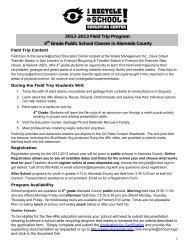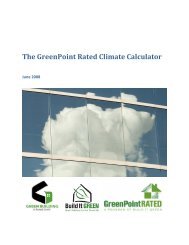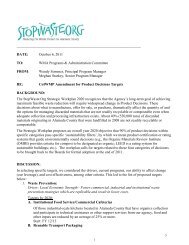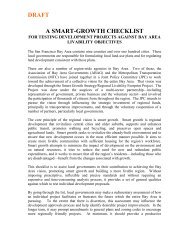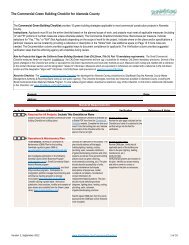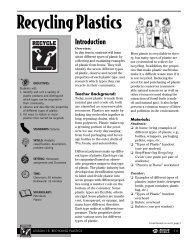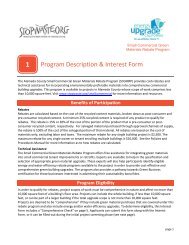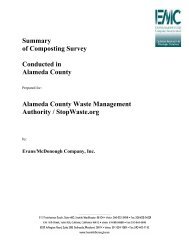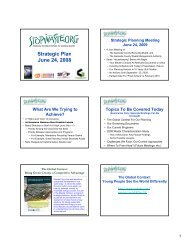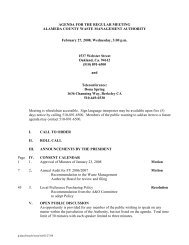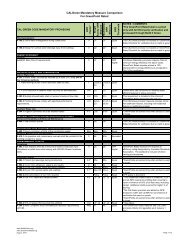Staff Report and WELO Ordinance - StopWaste.Org
Staff Report and WELO Ordinance - StopWaste.Org
Staff Report and WELO Ordinance - StopWaste.Org
- No tags were found...
Create successful ePaper yourself
Turn your PDF publications into a flip-book with our unique Google optimized e-Paper software.
Draft 10-13-10shall be submitted as part of the l<strong>and</strong>scape design documentation package.1. Plant Selection <strong>and</strong> Grouping. Any plants may be used in the l<strong>and</strong>scape, with waterconserving plant species encouraged, subject to the following conditions.a. Water budget compliance. The estimated applied water use recommendeddoes not exceed the maximum applied water allowance.b. Use of hydrozones. Plants having similar water use shall generally be groupedtogether in distinct hydrozones (see subsection (B)(3) of this section). Other considerationsfor establishing hydrozones may include sun exposure, soil condition, <strong>and</strong> slope. Plantshaving nearly similar water use may be grouped together, that is, high <strong>and</strong> medium waterusing plants may be grouped, or medium <strong>and</strong> low water using plants may be groupedtogether. However, high <strong>and</strong> low water using plants shall not be grouped together in the samehydrozone. For mixed plant hydrozones, the more water intensive plant factor (highernumber) shall be used for the entire hydrozone.c. Amount of turf. Total irrigated areas specified as turf shall be limited to 50% forresidential uses <strong>and</strong> 25% for non-residential uses, with turf bioswales necessary forstormwater treatment <strong>and</strong> recreational areas exempted.d. Invasive plant species. Plants listed as invasive (A, B, <strong>and</strong> C rated) by theCalifornia Department of Food <strong>and</strong> Agriculture (CDFA), or listed as invasive (high ormoderate rated) by the California Invasive Plant Council's (IPC) database of invasive species,shall not be used, except a turf plant rated C by CDFA or rated Moderate by Cal-IPC shall bepermitted for use on sports fields <strong>and</strong> high traffic recreation areas. Project applicants mayrequest to use other plant specie(s) rated C by CDFA or rated Moderate by Cal-IPC providedthe request is substantiated by evidence submitted to <strong>and</strong> approved by the director thatclearly establishes that due to plant or site characteristics the use of the requested plant willnot have detrimental ecological effects on parks, greenbelts, waterbodies, water ways, <strong>and</strong>open spaces.e. Fire prone areas. L<strong>and</strong>scapes in fire prone wildl<strong>and</strong> areas shall be designed tocomply with any applicable Fire Department regulations <strong>and</strong> to create a defensible spacearound a building as required by Public Resources Code Section 4291.f. Homeowners Associations <strong>and</strong> Common Interest Developments. Thecovenants, codes <strong>and</strong> restrictions (i.e., CC&Rs) of a common interest development, whichmay include but not be limited to community apartment projects, condominiums, planneddevelopments, stock cooperatives, or single family subdivisions governed by a HomeownersAssociation shall not prohibit or include conditions that have the effect of prohibiting the useof low-water use plants as a group. Further, said guidelines shall not prohibit the removal ofturf, nor restrict or prohibit the reduction of turf in lieu of more water efficient alternatives.2. Water Features.a. Recycled water where it is an approved supply of water shall be used for alldecorative water features.b. Recirculating water shall be used for all decorative water features.c. Pool <strong>and</strong> spa covers are highly recommended.3. Soil erosion <strong>and</strong> runoff management.a. The l<strong>and</strong>scape <strong>and</strong> grading plans shall be coordinated to minimize irrigation<strong>and</strong> stormwater runoff <strong>and</strong> to maximize on-site retention <strong>and</strong> infiltration of irrigation water <strong>and</strong>stormwater. Examples of practices include but are not limited to directing runoff to l<strong>and</strong>scapeareas, bioswales, rain gardens <strong>and</strong>/or similar features.1480



